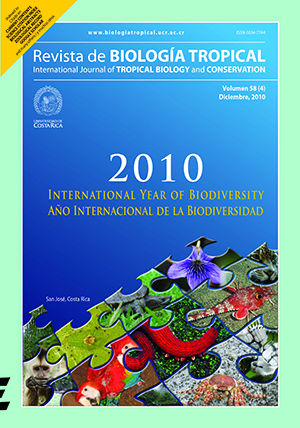Abstract
Natural lake systems represent important reservoirs for residential water supply, fish production, recreational activities and enjoyment of their natural beauty. Nevertheless, human impacts may affect their health status resulting in degradation and loss of biodiversity. The aim of the present study was to obtain data on the health status of a natural lake located in an indigenous reservation in the Brazilian Amazon, using the phytoplankton community changes along the rainy (June) and dry (November) seasons of 2006. We collected water (temperature, pH, Secchi depth and conductivity) and phytoplankton samples from the subsurface, middle of the water column, and approximately 30cm above the bottom, over 24-hour sampling periods, from a central station in the lake. Samples taken from biotic and abiotic variables were correlated using canonical correspondence analysis (CCA). Results showed that the lake exhibited high temperatures in both seasons, and showed thermal stratification only during the rainy season. Dissolved oxygen exhibited a clinograde pattern in the rainy season and high oxygen in the hypolimnion in the dry season. In the rainy season, the water near the bottom was acidic, turbid and had a greater concentration of phosphorus. Dissolved oxygen, conductivity, pH, nitrite, total phosphorus and total dissolved phosphorus exhibited diel variations in the rainy season, whereas water temperature, dissolved oxygen, total nitrogen and total dissolved phosphorus exhibited significant differences between hours of the day in the dry season. The phytoplankton was represented by 39 taxa, and Chlorophyta showed the greatest species richness, totaling 25 taxa. Among Chlorophyta, desmids were the most diverse, accounting 52%. Bacillariophyta (nine species) was the second most diverse group. Cyanophyta was represented by three species, including Merismopedia tenuissima, the most abundant taxon. Despite the occurrence of taxa that indicate organic pollution, their biomass and frequency indicate that the system is not currently threatened. Lake Caracaranã is an oligotrophic system, with low algal density and isolated blooming episodes due to its shallow depth.
This work is licensed under a Creative Commons Attribution 4.0 International License.
Copyright (c) 2010 Revista de Biología Tropical

